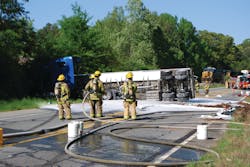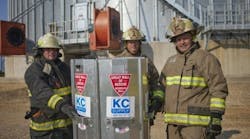Following the 9/11 terrorist attacks, fire and police officials in Gwinnett County, GA, recognized the increased potential for foreign and domestic terrorism and saw a need to share resources, knowledge, information and experience. In 2003, fire and police command staff began discussing ways in which the fire department’s hazardous materials team and the police department’s bomb unit could work together.
Today, Gwinnett County has one of the most comprehensive hazmat teams and hazardous devices units in the Southeast. It is the only response model comprising of fire and police in the Metro-Atlanta area and has become an example for other agencies. Through this collaboration, both teams have mitigated high-profile incidents, including drug seizures, accidental hazmat releases and potential and real explosive devices.
Protected population
Gwinnett County is approximately 30 miles northeast of Atlanta and covers 437 square miles and a population of 837,873. It is the second-most-populated county in Georgia after Fulton, which borders Atlanta. One of the fastest-growing counties in the United States for the past 20 years, Gwinnett County was created in 1818 by the State Legislature from part of Jackson County and frontier land ceded to the state by the Creek Indians. The county was named for Button Gwinnett, a signer of the Declaration of Independence.
Gwinnett County firefighters protect the entire county except Loganville, which is partly in Walton County. Fire Chief Bill Meyers has 850 uniformed and civilian personnel under his command. The department responds with 30 engine companies, 10 truck companies, the Hazardous Materials Response Team, 23 medic units, bicycle medics, technical rescue and swiftwater rescue teams and two manpower squads. Firefighters operate out of 30 stations, with Station 31 under construction and due to be occupied in late 2013. Station 31 will protect Georgia Gwinnett College in Lawrenceville with an engine, truck, medic and shift commander.
Before a full-time, paid fire department existed in Gwinnett County, each county district had its own fire plan and protection. In 1967, seven lives were lost in the Norcross area of the county due to fires. This prompted county commissioners to offer districts a countywide fire protection plan. A countywide referendum was held in 1970, but failed by a 4-1 margin, supported only in the Pinckneyville District. Commissioners made another effort to consolidate fire protection by mandating that if one district wanted county fire protection, individual districts could vote it in. In 1970, the Pinckneyville District was the first area to vote in favor of county fire protection. On March 30, 1971, at 10:15A.M., the Gwinnett County Fire Department responded to its first alarm. The new department had 10 firefighters and one engine and a budget of $89,000. Over the next 10 years, the department’s protection was so well received by Gwinnett citizens and businesses alike that other cities and districts voted to be included in the county coverage. Thirty years later, what is now the Gwinnett County Department of Fire and Emergency Services is the largest fire service district in the state based on number of legal jurisdictions under one department.
Gwinnett County firefighters responded to 66,757 calls for assistance in 2012, including 4,845 fire calls and 50,028 medical calls. Firefighters work an average 54-hour work week with minimum staffing on engines and trucks of three personnel. The Gwinnett County Fire Academy provides recruit and in-service training with facilities that include a burn building, training tower, apparatus building, drafting pit, low-speed driving course and classrooms.
The fire department formed a hazmat team in the mid-1980s as a result of hazmat calls that occurred in the count. The team originally was based in the western part of the county near several chemical and manufacturing facilities, a major interstate highway and two rail lines. All personnel were trained to the technician level and equipped with response vehicles that included a quick-response vehicle (QRV) and a hazmat unit. Additional equipment and vehicles were purchased as needed. The team was eventually moved to Station 20 in Lawrenceville, where it is located now.
Housed at the hazmat station are Hazmat 20, Medic 20, a pod truck (featuring mass-decontamination and bulk-storage pods), the manpower squad that carries four personnel and the water tender, which carries 3,000 gallons of water and 100 gallons of foam concentrate. Two personnel are assigned to Hazmat 20 on each shift and the remaining units are dispatched as needed. An average of 16 technician-level personnel are on duty each shift with a maximum of 22 at full staffing. Hazmat 20 also responds to medical and fire calls as needed. The hazmat team answers 300 to 400 calls per year, including fuel spills, gas odors and leaks. Engine companies carry absorbent materials and handle spills of five to 10 gallons, but greater-volume spills require the response of the hazmat team. Mutual aid is provided by the DeKalb County hazmat team. Personnel assigned to Station 20 are trained to the technician level and all other firefighters are trained to the operations level. Technician-level training is given in-house and additional training is provided by National Fire Academy classes and Department of Homeland Security courses in Alabama, Nevada and New Mexico.
Equipping responders
Respiratory protection for the hazmat team is provided by Scott 60-minute bottles. The team also carries air-purifying respirator (APR) masks for protection against chemical agents. Chemical suits used by the team include the Saint-Gobain ONESuit Flash chemical protective hazmat suit for Level A and Level B and DuPont Tychem. Monitoring equipment includes the RAE Systems four-gas detector and four-gas with Photoionization Detector (PID); Sensit Gold four-gas leak detector; Sensit Gold two-gas detector; Honeywell EC-P2 gas sensor with chlorine and ammonia chips; Thermo Scientific FirstDefender RMX spectrometer and Scientific TruDefender FT and FTi hand-held spectroscopy devices; Ludlum 14C Survey radiation meters; Smith’s Detection APD 2000 chemical detector and LCD 3.2E lightweight chemical warfare agent detector; FLIR IdentiFINDER 2 nuclide radiation meter; Canberra UltraRadiac Plus personal radiation monitor; and Drager pump. Four Panasonic Toughbook laptop computers are available to team members.
Major transportation exposures for potential hazmat incidents in Gwinnett County include Interstate 85, State Highways 20 and 985, and U.S. Highways 23, 29 and 78. The CSX and Norfolk Southern railroads have lines into and through the county. Pipeline exposures are comprised of major natural gas pipelines and the Plantation Pipeline Co. Fixed hazmat exposures include a U.S. Postal Service facility that processes 50% of the mail in Georgia and that has a biological-agent detection system. The federal Centers for Disease Control (CDC) has a satellite facility in Gwinnett County with biological hazards. Specific chemicals found in the county include chlorine, propane, ethanol and anhydrous ammonia.
Police bomb personnel are trained as hazmat technicians. When the fire department’s Station 31 is completed at the end of 2013, the police bomb team will house its response unit, equipment and offices there along with fire and EMS crews.
Part two of this column focuses on how fire and police personnel work together to mitigate emergency situations that previously were handled separately. For questions or additional information, contact Deputy Chief of Operations Charles Wells at [email protected].






